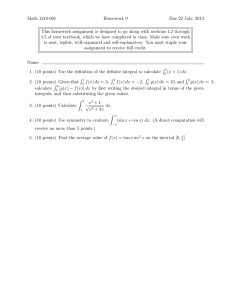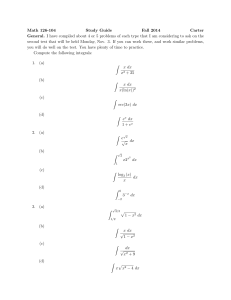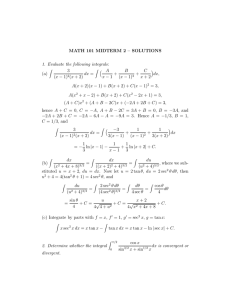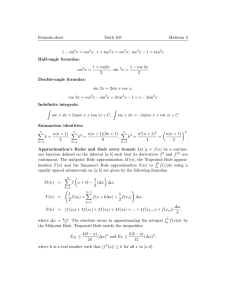1. Compute the following integral: √ � t ln t dt
advertisement
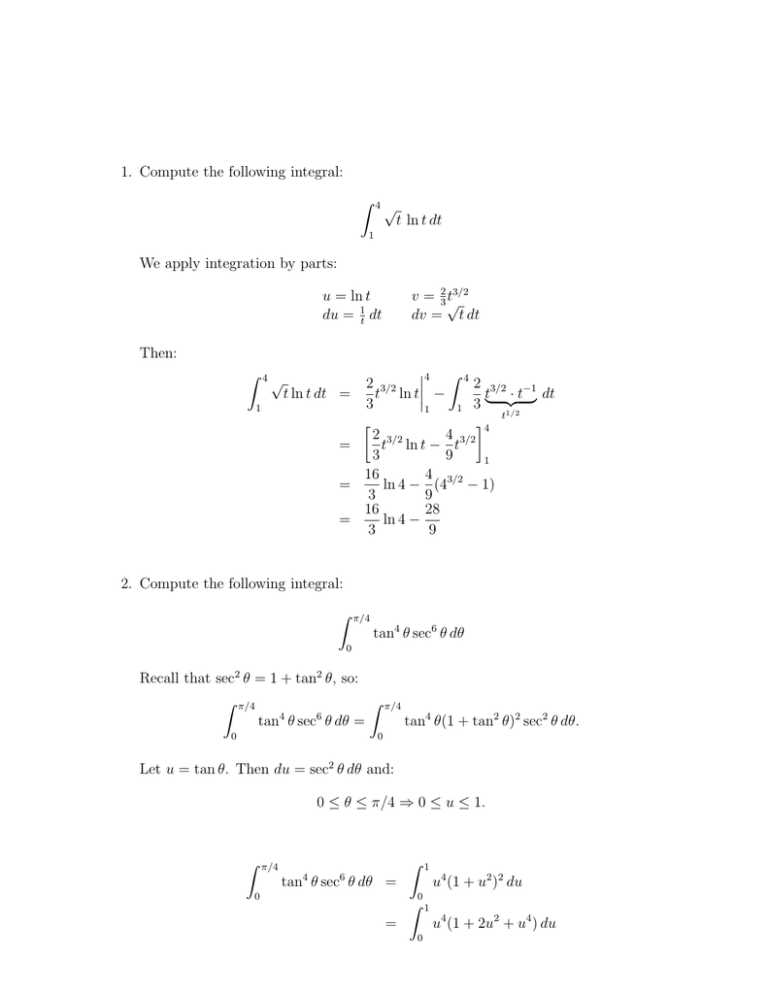
1. Compute the following integral: 4 � √ t ln t dt 1 We apply integration by parts: v = 23 √ t3/2 dv = t dt u = ln t du = 1t dt Then: 4 � �4 � 4 � 2 3/2 2 3/2 −1 t ln t�� − t� �� · t � dt 3 1 3 1 1/2 t � �4 2 3/2 4 = t ln t − t3/2 3 9 1 16 4 3/2 = ln 4 − (4 − 1) 3 9 16 28 = ln 4 − 3 9 √ t ln t dt = 1 2. Compute the following integral: � π/4 tan4 θ sec6 θ dθ 0 Recall that sec2 θ = 1 + tan2 θ, so: � π/4 4 π/4 � 6 tan4 θ(1 + tan2 θ)2 sec2 θ dθ. tan θ sec θ dθ = 0 0 Let u = tan θ. Then du = sec2 θ dθ and: 0 ≤ θ ≤ π/4 ⇒ 0 ≤ u ≤ 1. � π/4 4 � 6 1 tan θ sec θ dθ = 0 �0 1 = 0 u4 (1 + u2 )2 du u4 (1 + 2u2 + u4 ) du � 1 (u4 + 2u6 + u8 ) du 0 �1 1 5 2 7 1 9 �� = u + u + u� 5 7 9 0 1 2 1 188 = + + = . 5 7 9 315 = 3. Compute the following integral: � � 10 dx = (x − 1)(x2 + 9) 10 dx (x − 1)(x2 + 9) � 1 x+1 − 2 dx x−1 x +9 � � � 1 x 1 = dx − dx − dx 2 2 x−1 x +9 x +9 � � 1 1 2 −1 x = ln(x − 1) − ln(x + 9) − tan +c 2 3 3 4. Compute the following integral: � � 1 dx (5 − 4x − x2 )5/2 1 dx = (5 − 4x − x2 )5/2 � 1 dx (9 − (2 + x)2 )5/2 Let x + 2 = 3 sin θ. Then dx = 3 cos θ dθ and: � � 1 3 cos θ dx = dθ 2 5/2 5/2 (9 − (2 + x) ) 9 (1 − sin2 θ)5/2 � 3 cos θ = dθ 35 cos5 θ � 1 = 4 sec4 θ dθ 3 Let u = tan θ. Then du = sec2 θ dθ. Recall that sec2 θ = 1 + tan2 θ. � � 1 1 4 sec θ dθ = 4 (1 + tan2 θ) sec2 θ dθ 34 3 � 1 = 4 1 + u2 du 3 � � 1 u3 = 4 u+ +c 3 3 � � 1 tan3 θ = 4 tan θ + +c 3 3 = sin θ. Sketch a right triangle whose opposite side has length We know that x+2 3 x + 2 and whose hypotenuse has length 3. Applying the Pythagorean theorem, we x+2 see that tan θ = √ . Therefore, 5 − 4x − x2 � � � 1 1 x+2 (x + 2)3 dx = 4 √ + + c. (5 − 4x − x2 )5/2 3 5 − 4x − x2 3(5 − 4x − x2 )3/2 5. (a) Set up (but do not solve) the integral for the arc length along the curve x = y + y 3 from y = 1 to y = 4. Parametrize the curve: y = t, x = t + t3 . � � 4 � Arc Length = dS = (x� (t))2 + (y � (t))2 dt t=1 � 4� (1 + 3t2 )2 + 1 dt. = 1 (b) Set up (but do not solve) the integral for the surface area of the surface obtained by rotating the curve given by x = a cos3 t, y = a sin3 t, 0 � t � π/2 about the x-axis. Here a is an arbitrary constant. � Surface Area π/2 � |a| sin3 t (x� (t))2 + (y � (t))2 dt = 2π t=0 π/2 � � |a| sin t (3a cos2 (t) sin(t))2 + (3a sin2 (t) cos(t))2 dt 3 = 2π 0 � π/2 � 3a sin t sin2 t cos2 t(cos2 t + sin2 t) dt 2 = 2π 3 0 2 � = 6a π 0 π/2 sin4 t cos t dt. MIT OpenCourseWare http://ocw.mit.edu 18.01SC Single Variable Calculus�� Fall 2010 �� For information about citing these materials or our Terms of Use, visit: http://ocw.mit.edu/terms.

